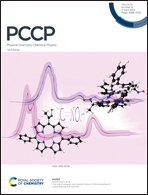Investigating the correlation between the protein adhesion simulation and the biocompatibility of polymeric substrate for skin-tissue-engineering applications†
Abstract
Investigating the protein adhesion properties of polymeric scaffolds through computational simulations can predict the biocompatibility of scaffolds before an experimental assay is carried out. This prediction can be highly beneficial since it can cut costs and the time it takes for experimental assays. The current study aims to test the hypothesis that there is a correlation between the biocompatibility of a composite scaffold and the molecular dynamics simulations of protein adhesion. To this end, chitosan and gelatin were selected for fabricating a composite skin-tissue wound scaffold with five different polymer ratios. This polymeric blend has not been simulated for protein adhesion. The cell proliferation and viability of the samples were quantified via MTT assay using fibroblast cells. Then a series of molecular dynamics simulations were performed to measure the adhesion energy of two prominent extracellular matrix proteins – fibronectin, and collagen type I. Besides, a higher gelatin percentage in the scaffold leads to a decrease in the porosity. The results demonstrated a strong correlation between the experimental data and molecular dynamics simulations. The sample with equal amounts of chitosan and gelatin had the highest cell viability and the strongest adhesion energy, of 239 kcal mol−1 for collagen type I, and 149 kcal mol−1 for fibronectin. This correlation was also evident in other samples: samples with gelatin-to-chitosan ratios of 3 : 1 and 1 : 3 had the lowest cell viability and the weakest adhesion energy, respectively.



 Please wait while we load your content...
Please wait while we load your content...